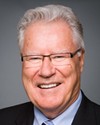First of all, Canada was one of the four leading nations in coming up with an international system for satellite-based detection of emergency beacons. Originally it was on frequency 121.5, which is a radio emergency broadcast frequency. All that it provided through satellite was a beacon detection initially, but no location. With subsequent satellite passage you got some location but it was not very localized. There was no information on the nature of the craft or vessel that had this beacon aboard.
The international community has switched to a designated frequency, frequency 406, which is now the emergency frequency. It's digital and it provides capability to encode information. Now if you have an aircraft and that's your distress frequency, it will go through the satellite to our mission control centre, which is located in Trenton, and give the information about the owner and type of craft. In addition, it will give a precise position of where you are. This is a tremendous advance in technology, and it helps search and rescue.
A number of vessels carry them, and they're called EPIRBs. There's a regulation that requires certain sizes of vessels to carry the EPIRB.
In the aviation community, with the 121, there used to be a regulation requiring mandatory carriage. The regulation is no longer in force because the satellites no longer broadcast or receive on 121. There is legislation, through Transport Canada--I think it's entered into the Gazette, or it will be soon--that will require the mandatory carriage of 406. While it's not yet mandatory, it will be soon, within the next year or so.
We are encouraging that the operators of private aircraft, and commercial operators, become equipped with 406 without delay. This is certainly the best insurance policy they could possibly purchase.





